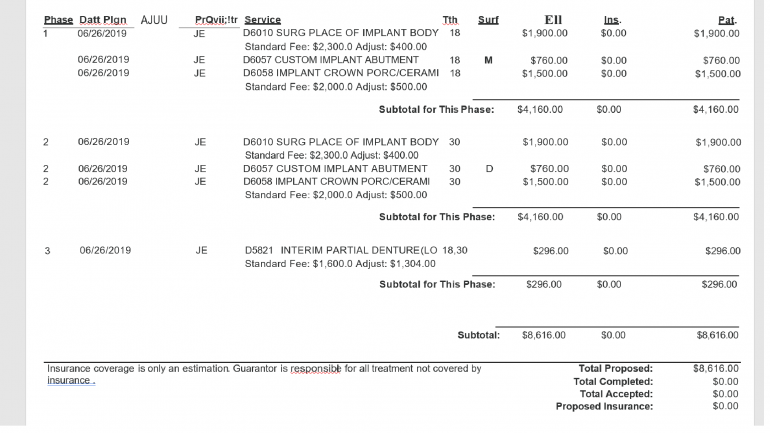
Dental Code D5951: Feeding aid
Dental Code D5951 refers to a specialized dental procedure known as a feeding aid. This dental code describes a treatment designed to assist individuals who face challenges with eating and feeding due to various dental or oral conditions.
What does Dental Code D5951 mean? Detailed Information about the Procedure and Steps
Dental Code D5951 pertains to a dental procedure focused on improving the eating and feeding experience for individuals facing challenges due to dental or oral conditions. This code represents the creation and placement of a personalized dental appliance, known as a feeding aid, which is designed to alleviate difficulties associated with eating and feeding. The feeding aid is tailored to meet the specific needs of each patient, providing enhanced comfort and functionality, ultimately improving their overall ability to eat and feed with greater ease.
Initial Assessment and Consultation
The first step in the Dental Code D5951 procedure involves an initial assessment and consultation with a dental professional, typically a dentist or a prosthodontist. During this stage, the dentist carefully evaluates the patient's oral health, assesses their specific needs and challenges related to eating and feeding, and discusses the available treatment options. This assessment helps determine whether a feeding aid is a suitable and necessary solution for the patient.
Impressions and Diagnostic Records
Once the decision to proceed with a feeding aid is made, the dentist takes impressions and diagnostic records of the patient's teeth and oral structures. These records include X-rays, photographs, and detailed measurements of the mouth. These impressions and records serve as the foundation for the fabrication of the feeding aid, ensuring a customized fit and optimal functionality.
Impressions are created using a soft, putty-like material that the patient bites into. This captures the precise shape and alignment of the teeth and surrounding tissues. X-rays and photographs provide additional information about the underlying bone structure, tooth roots, and overall oral health. These diagnostic records help the dentist accurately assess the patient's condition and plan the design of the feeding aid.
Design and Fabrication of the Feeding Aid
Based on the diagnostic records, the dentist collaborates with a dental laboratory to design and fabricate the feeding aid. The feeding aid is typically a removable dental appliance, similar to a denture, but specifically designed to aid in the process of eating and feeding. It is custom-made to address the unique requirements of the patient, considering factors such as tooth alignment, oral anatomy, and functional needs.
The design process involves using advanced computer-aided design (CAD) software to create a digital model of the feeding aid. This model is then used to fabricate the appliance using high-quality materials. The dental laboratory technicians carefully follow the dentist's specifications to ensure the feeding aid fits comfortably and functions effectively.
Fitting and Adjustment
Once the feeding aid is fabricated, the patient returns to the dental office for fitting and adjustments. The dentist ensures that the feeding aid fits securely and comfortably in the patient's mouth. Any necessary adjustments are made to optimize its function and ensure proper alignment with the patient's existing teeth and oral structures. The dentist may use special tools to make minor modifications to the feeding aid, such as adjusting the shape or thickness of certain areas for improved comfort.
During this stage, the dentist provides detailed instructions on how to insert, remove, and care for the feeding aid. Proper maintenance and hygiene practices, including regular cleaning and storage recommendations, are explained to the patient or their caregiver.
Follow-up and Maintenance
Regular follow-up appointments are crucial to monitor the effectiveness and comfort of the feeding aid. The dentist assesses the patient's progress, makes any necessary adjustments, and addresses any concerns or issues that may arise. The patient's feedback is invaluable during these appointments, as it helps the dentist fine-tune the functionality and fit of the feeding aid.
Additionally, the dentist provides guidance on long-term maintenance and hygiene practices for the feeding aid. This includes proper cleaning techniques, recommended cleaning solutions, and storage instructions. Regular check-ups and professional cleanings may also be advised to ensure the feeding aid continues to perform optimally and the patient's oral health remains in good condition.
Summary of Dental Code D5951
Dental Code D5951, the feeding aid procedure, offers a viable solution for individuals facing challenges with eating and feeding due to dental or oral conditions. The procedure involves an initial assessment and consultation, followed by the creation of diagnostic records, design, and fabrication of a customized feeding aid. The fitting and adjustment stage ensure optimal comfort and functionality. Regular follow-up appointments and maintenance are essential to monitor progress and address any concerns. By utilizing Dental Code D5951, dental professionals can provide individuals with the necessary support to improve their oral health and overall well-being.
Discover the art of savvy dental spending with Dr. BestPrice ! Your budget and your smile will thank you.
